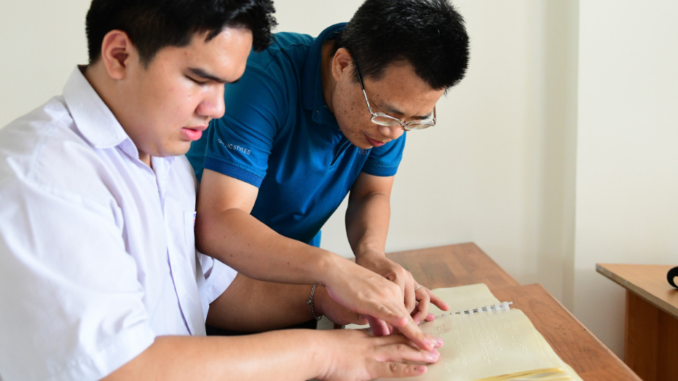
HO CHI MINH CITY – For more than a decade, on weekends, teachers at Nguyen Dinh Chieu Special School (District 10) focus on making braille textbooks for students.

Every Friday afternoon, at the library equipment room of Nguyen Dinh Chieu Special School (District 10), more than 30 teachers of the school gather here to make floating books. Each person has a job such as typing, arranging pages, pasting pictures, printing… This work has been done by the school for a long time, most focused on the summer.
“Due to the new educational program, students do not have many materials, so teachers have to convert regular textbooks into braille for students in grades 3, 7, 10 to keep up,” said principal Nguyen Thi Thanh. Hue said.

In another room, teacher Nguyen Van Thong converts each page of a soft copy of a textbook from word to word to braille before printing it with a specialized machine.
“Thanks to the conversion software, the work is faster. However, people have to read it carefully to correct the errors. The most common are misspellings, math formulas, physics and chemistry,” said Mr. Thong.
As a teacher of Mathematics and Braille at Nguyen Dinh Chieu Special High School since 2012, Mr. Thong is often the one to pass on his experience to other teachers.

With pages with pictures, the work is more complicated. Teachers will select images that can be converted to braille documents, design them via computer, then cut and paste them into pages with pictures with braille to create blanks, then press them to form a complete book.
In the afternoon of the same day, a group of female teachers worked together to make embossed figures in the 10th grade biology textbooks before printing them in bulk.

Teacher Tuyet Loan uses a ruler and pencil to position the embossed image on the blank page. “Not every picture in a textbook can be included in a floating book. We have to choose the most necessary image for the lesson or which image can be easily felt by the blind students,” the female teacher said. 40 years old said.

The relief is often compared to see if it has a standard shape and position with the original image. Materials for making embossed images are usually paper, thin wood, toothpicks, thread… to create different roughnesses and withstand heat when pressed into books.
In three hours of making books, depending on the skill and complexity of the picture, each teacher can make from 2 to 4 pages of floating books. Many teachers also bring this work home, especially during the summer break, they work almost from morning to night, including weekends.

Each page of the book, after being typed in braille, and pasted with pictures, will be put into an insulating printer for mass printing.

Teacher Nguyen Minh Hau uses specialized paper to print books. Each print takes about 5 minutes to complete a page with pictures.

“Printing requires experienced people who know how to properly monitor the temperature to ensure that the text and images will float evenly,” said teacher Nguyen Phi Hung, while comparing a print with the blank (white).

The printed pages of the book are then checked by the teacher and students to see if there are any errors such as spelling, missing punctuation, wrong formula, irregular braille… According to the principal, the school has just finished it. be the first semester of the textbook of the block.

A group of 3rd graders is learning a new program from a braille textbook set by their school’s teachers.
Nguyen Dinh Chieu Special High School was established in 1926, with the original name being Saigon Blind School. The school currently has more than 300 students with disabilities, from preschool to high school and vocational training in the form of special education. Students are taught general and specialty subjects as well as free apprenticeships and boarding.
(According to vnexpress )
